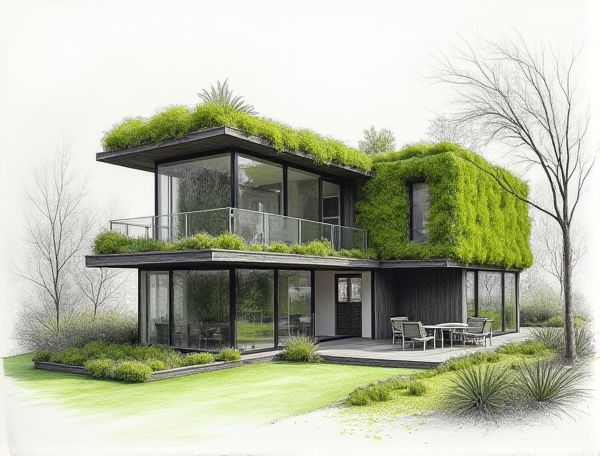
Photo illustration: Biophilic home design with moss walls
Incorporating moss walls into your home design enhances natural air quality and creates a calming environment that brings the outdoors inside. Discover how this biophilic design approach can transform your living space by reading more in the article.
Introduction to Biophilic Home Design
Biophilic home design integrates natural elements such as indoor plants, natural light, and organic materials to enhance wellbeing and create a harmonious living environment. Emphasizing a connection to nature, this design approach improves air quality, reduces stress, and boosts creativity while promoting sustainable architecture.
The Science Behind Biophilia and Well-being
Biophilia in home design harnesses nature's calming effects by integrating natural elements such as plants, natural light, and organic materials, which reduce stress and enhance mental clarity. Scientific studies reveal that exposure to biophilic environments boosts serotonin levels, improves cognitive function, and accelerates healing, promoting overall well-being and productivity within living spaces.
Moss Walls: A Unique Biophilic Element
Moss walls bring a distinctive biophilic element to home design by enhancing indoor air quality and providing natural sound insulation. These living installations require minimal maintenance and thrive in low-light environments, making them ideal for various interior spaces. Integrating moss walls promotes wellness and a sustainable aesthetic that connects occupants with nature.
Health and Environmental Benefits of Moss Walls
Moss walls improve indoor air quality by naturally filtering pollutants and increasing humidity, promoting healthier breathing environments for you. They also reduce noise pollution and require minimal maintenance without harmful chemicals, making them an eco-friendly choice for sustainable home design.
Types of Moss Used in Interior Design
Various types of moss, such as sheet moss, reindeer moss, and mood moss, are popular choices in interior design due to their vibrant colors and textured appeal. Sheet moss offers a flat, lush surface ideal for wall art and terrariums, while reindeer moss provides a soft, cushiony feel perfect for decorative panels. Incorporating these moss types into your home design enhances natural aesthetics and promotes a calming atmosphere.
Creative Ways to Incorporate Moss Walls at Home
Transform your living space with moss walls by integrating them as natural accent features in areas like the living room, bathroom, or home office to enhance air quality and add organic texture. Choose preserved moss varieties that require minimal maintenance while providing vibrant green hues, creating a soothing ambiance that complements your interior design. Your creativity in arranging moss walls with complementary elements such as wood panels or stone backgrounds will elevate your home's aesthetic and promote a calming environment.
Maintenance Tips for Long-lasting Moss Installations
Regularly misting your moss installation maintains optimal moisture levels, preventing dryness without causing over-saturation that can lead to mold growth. You should also gently dust the moss weekly and avoid direct sunlight to preserve its vibrant color and longevity in your home design.
Enhancing Indoor Air Quality with Moss Walls
Moss walls naturally improve indoor air quality by absorbing pollutants, filtering toxins, and regulating humidity levels in your living space. These living green installations also reduce airborne dust and provide a calming, biophilic element that enhances overall well-being. Integrating moss walls into your home design creates a healthier, fresher environment while adding a striking aesthetic feature.
Cost and Sustainability Considerations
Selecting eco-friendly materials such as bamboo, recycled steel, and low-VOC paints significantly reduces environmental impact while often lowering long-term costs through durability and energy efficiency. Incorporating sustainable design elements like solar panels, proper insulation, and energy-efficient windows decreases utility expenses and enhances the home's overall value.
Future Trends in Biophilic Home Design
Future trends in biophilic home design emphasize the integration of natural elements such as living walls, indoor gardens, and organic materials to enhance mental well-being and indoor air quality. Smart home technology will increasingly complement these features by optimizing natural light, ventilation, and plant care for a harmonious and sustainable living environment.
 homedesy.com
homedesy.com